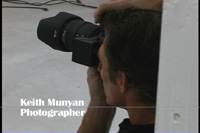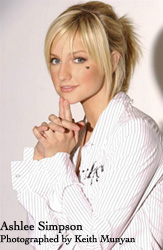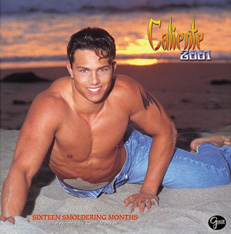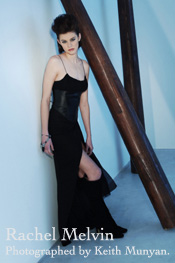Keith Munyan – Making the Transition from Model to Photographer Look Easy
 Keith Munyan has modeled for fifteen years and has been on calendars, appeared on “EXTRA,” “Hard Copy,” and “Access Hollywood.” He was featured on billboards for Bud Light, modeled for Diet Coke, did countless commercials, and was a very successful swimsuit model. One would never expect to see him—with those rugged good looks of his—behind the camera. Keith uses his modeling experience to create great photographs, capturing some of the biggest celebrities on film. His client list reads like an all-star cast with celebrities like Jessica Simpson, Cindy Crawford, and Hilary Duff.
Keith Munyan has modeled for fifteen years and has been on calendars, appeared on “EXTRA,” “Hard Copy,” and “Access Hollywood.” He was featured on billboards for Bud Light, modeled for Diet Coke, did countless commercials, and was a very successful swimsuit model. One would never expect to see him—with those rugged good looks of his—behind the camera. Keith uses his modeling experience to create great photographs, capturing some of the biggest celebrities on film. His client list reads like an all-star cast with celebrities like Jessica Simpson, Cindy Crawford, and Hilary Duff.
Was it hard to transition from modeling in front of the camera to moving behind the camera?
Because of my experience from working in front of the camera, I listened a lot regarding lighting, and shooting. I found it easier for me because I enjoyed working with people.
Do you think having been a model helped your eye when shooting other models?
Yes, I do. One of the things I’ve learned is patience. Don’t rush. I’m more laid back. When we’re doing shoots, if you have an idea, let’s try it. I’ll try anything, because I’m not always right. If you can give your input and enjoy the job, it goes by faster, and everybody has a fun day.
Who are some of the people you have shot?
I knew a guy from a magazine who found out I was shooting. I shot Beth Broderick, who plays Aunt Zelda on “Sabrina the Teenage Witch.” The television show used all my photos in the background as they did a story on her character. Because of that show, and from knowing me as a model from Popstar!Magazine, he called me and asked me if I was interested in shooting. And I said sure, why not? I’d be glad to do it. The first person I shot was Jessica Simpson. Then later, I shot Cindy Crawford, Carmen Electra, Hilary Duff, whom I’ve worked with for over four years now, as well as countless other celebrities, and just recently, Rachel Melvin for Agenda Magazine. All my work is by word of mouth or by referral. I do not advertise.
plays Aunt Zelda on “Sabrina the Teenage Witch.” The television show used all my photos in the background as they did a story on her character. Because of that show, and from knowing me as a model from Popstar!Magazine, he called me and asked me if I was interested in shooting. And I said sure, why not? I’d be glad to do it. The first person I shot was Jessica Simpson. Then later, I shot Cindy Crawford, Carmen Electra, Hilary Duff, whom I’ve worked with for over four years now, as well as countless other celebrities, and just recently, Rachel Melvin for Agenda Magazine. All my work is by word of mouth or by referral. I do not advertise.
In Rachel’s shoot we used a lot of wood elements. We kept it very vogue, very high fashion, but we threw in the wood elements to keep the warmth, to keep it grounded to make it more special and individualized for her.
I did like the idea of the wood. How do you come up with ideas for different shoots? Do you ever end up duplicating your ideas?
I look. I shop. I find elements and things for backgrounds. And then once I see the clothing and get the feel, we started pulling things in. The Yucca tree that we used forAgenda Magazine for Rachel Melvin was actually from off of my property. It was just a dead yucca that had bloomed and it died, but we saved it. The vase from the Malibu fires went with the elements; something rustic, something used, but then you’ve got elegance with it. I see a lot of photos and ideas from other magazines… Yes, I look; I shop. You’ve got to keep your eye going, you’ve got to stay up on fashion with your shooting, and know what’s happening with photographers. So you’ve got to keep up.
Do you have any secret tips for yourself when you’re actually shooting, like trade secrets that you use to pull a photo out of someone?
Sometimes I do. The best thing to do when you’re working with a celebrity is to remind them to think of the people they love and care about or their pet. And they laugh. Like with Rachel, we brought up Murphy, her cocker spaniel, and her eyes lit up, and she was very relaxed.
Have you ever had a disaster shoot?
When you’re dealing with celebrities, you’re dealing with personalities. Some PR people do not get along with their celebrities. And then you deal with celebrities that think they’re bigger than other people… and I can’t mention any names… but everyone thinks she is a diva, but she’s a clock-watcher. They only give you so many hours to shoot this editorial for a hair magazine,Sophisticated Hair, and we were doing the hair stuff on her and she saw the clock and decided it was time for her to leave. I told her she’d only been here an hour. Her mother told her she wasn’t going anywhere. When she excused herself and turned her back, I took the clock down, told her mother to hide her watches, hide everything… and she stayed for three more hours. She was trying to rush us through our job, and without these photos, she didn’t have the publicity. They were doing the story on her. She had the cover already. Just be nice. That’s the only bad experience I had. Everybody else who I’ve worked with has been amazing.
I enjoy doing the celebrity stuff because everyone is usually so pleasant. I do not do the paparazzi, and very seldom will I do weddings. No! (He shrugs.) Weddings are not fun. People do not understand that weddings are the hardest thing on a photographer or because you have no control. The mother does. (Laughs.)
I noticed when you were shooting Rachel, you had a very elaborate light setup. Can you tell me how you came about doing textures through lighting like you did on her shoot?
For one thing, dealing with celebrities, you have to make sure everything is perfect. And I learned over the years to test the lighting, and use more light because most of the time, not everyone always has the perfect skin and complexion, and not everyone gets Photoshopped. So I’ve learned how to adjust my lighting around my clients. I figure out how to make it hotter, warmer, darker, depending on their skin tones, their hair, their makeup. I like to mix my Tungsten lighting with my daylight to give you that blue hue, which gives you that porcelain look, almost China doll. Not everyone has that perfect warm skin. Not everyone’s a fitness model. Not everyone’s tan. Like Rachel, the lighting we used on her was the Tungsten lighting, but I shot it as daylight to give her that porcelain look, yet the tones stayed rich and vibrant.
learned over the years to test the lighting, and use more light because most of the time, not everyone always has the perfect skin and complexion, and not everyone gets Photoshopped. So I’ve learned how to adjust my lighting around my clients. I figure out how to make it hotter, warmer, darker, depending on their skin tones, their hair, their makeup. I like to mix my Tungsten lighting with my daylight to give you that blue hue, which gives you that porcelain look, almost China doll. Not everyone has that perfect warm skin. Not everyone’s a fitness model. Not everyone’s tan. Like Rachel, the lighting we used on her was the Tungsten lighting, but I shot it as daylight to give her that porcelain look, yet the tones stayed rich and vibrant.
Tell me about your partner. I noticed it was a joint effort. You’re shooting, and he’s directing the model.
The funny thing is, Dean’s my partner for almost eighteen years. He’s been my business partner, and he was actually a photographer first. He would always do the shoots, and I would always direct the models, but now it’s reversed. He’s taken over my business part in running my business, whereas I’m doing the shoots, and he does the directing of the models because sometimes I get very quiet and more involved in what’s going on with the elements, the shots, the angle I want, the lighting… I make sure that everything is perfect and I’ll get quiet sometimes. There’s always going to be somebody ballsy on the set anyway, so why not have somebody who’s got a lot of energy. He is so funny. He can get hysterical. He’ll show people how to pose and they’re laughing, and everybody enjoys it. It’s fun. It’s entertaining. Everybody loves him. We’re sort of a team.
Before you shoot with a client, do you consult with them first? And how do you learn their angles?
I ask, before I shoot with someone, if they have an old photo, bring it. Show me what you like and don’t like about a photo. Bring it in. Because they’re going to have a side they like better. It’s about the lighting that you use with the person and still know their angles.
Do you miss the modeling?
No, I don’t. I miss the auditions, the cattle calls, where 300 people show up, and they’re looking for one model. I did that for fifteen years and I enjoyed it. I loved it. I traveled a lot. I got a lot of experiences. I did things I thought I’d never do. In Barcelona, I went up and down an escalator, dressed coming down, and naked going up. I didn’t think I would ever do that. But hey, they paid us triple. Why not? I was a starving model then. I was in my 20s. But I prefer being behind the camera now.
What’s next for you?
I want to make videos. I like the energy of music videos. It’s a little more pushed. I like the idea that it takes a lot of energy. You have to stay up and going all day, but you still treat it like a still shoot. The elements you use are almost the same.
Interviewed by Kaylene Peoples
